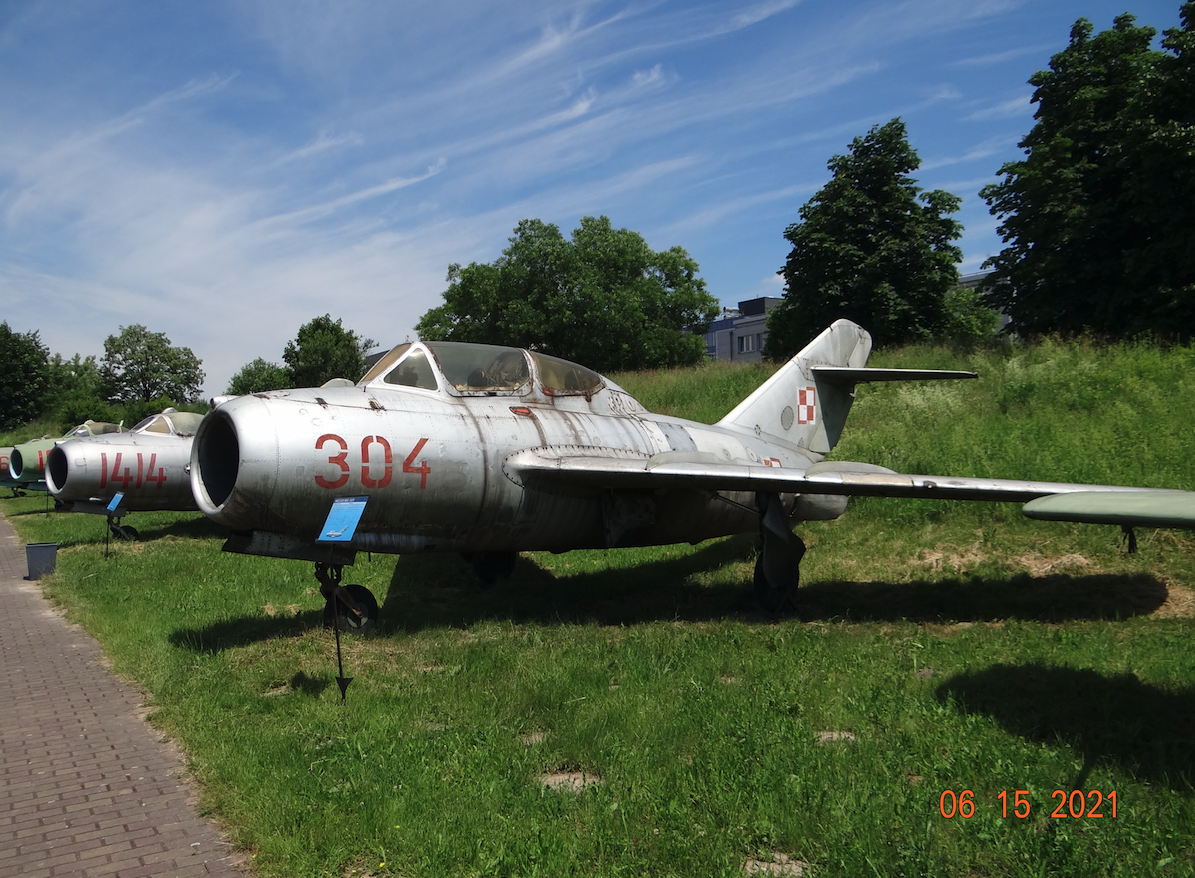Kraków 2008-01-29
62nd Fighter Aviation Training Regiment.
62nd Fighter Aviation Regiment.

1954.
The 62nd Fighter Aviation Training Regiment was established as a result of the need for a training unit capable of converting graduates of the Officer Aviation School No. 5 in Radom to turbojet aircraft. Young pilots left the academy with little experience in piston aircraft and no experience flying turbojet aircraft. Only a few had familiarization flights in Yak-17W/Agata aircraft. Combat units were not equipped to conduct this type of training.
On September 4, 1954, a decree of the Minister of National Defense was published, laying the foundation for the formation of a training unit, designated the 62nd Fighter Aviation Training Regiment. The base was Krzesiny airfield near Poznań. The formation of the unit began on September 17, 1954, based on a squadron from the 11th Fighter Aviation Regiment, for which a new airfield was planned in Debrzno. The 62nd PSzk-TLM began as a two-squadron formation. Operationally, the unit was subordinated to the 6th Fighter Aviation Division of the Air Force OK.
The first commander of the 62nd PSzk-TLM was Captain Pilot Andrzej Dobrzeniecki. His deputy for piloting was Captain Pilot Czesław Miodoński. Captain Pilot Stanisław Halerz became the regiment’s navigator. The small instructor staff initially included Czesław Bil, Zygmunt Lewiński, Mieczysław Maliga, Zbigniew Możdżeń, Antoni Łącki, Bolesław Kajetańczyk, and Janusz Leszczyński.
At that time, the infrastructure at Krzesiny Airport was very poor. During World War II, the Germans built an aircraft factory in Krzesiny. By the end of the war, all the facilities were severely damaged. After the war, the surviving steel structures were used to build production halls in various parts of Poland. The damaged brick buildings were provisionally adapted to their intended functions. However, they did not even meet the standards of the time. All roads within the airport were gravel, even the taxiways. The concrete runways were 50% destroyed.
Initially, the 62nd PShk-TLM operated two-seat UTI MiG-15s, MiG-15s, and PZL Lim-1s. In 1955, the regiment received its first PZL Lim-2s. The regiment also operated Yakovlev Yak-11 piston aircraft. The unit’s instructor staff included cadets who had already trained within the regiment. Training was very intensive. Flights were conducted both before and after noon. Only bad weather could interrupt the flight training. Theoretical training was then conducted in the lecture hall or alongside the aircraft. During the three years of its operation, the 62nd PSzk-TLM trained over 230 pilots from other combat regiments and three groups of cadets from Radom, School No. 5. During this period, the regiment accumulated 7,500 flight hours.
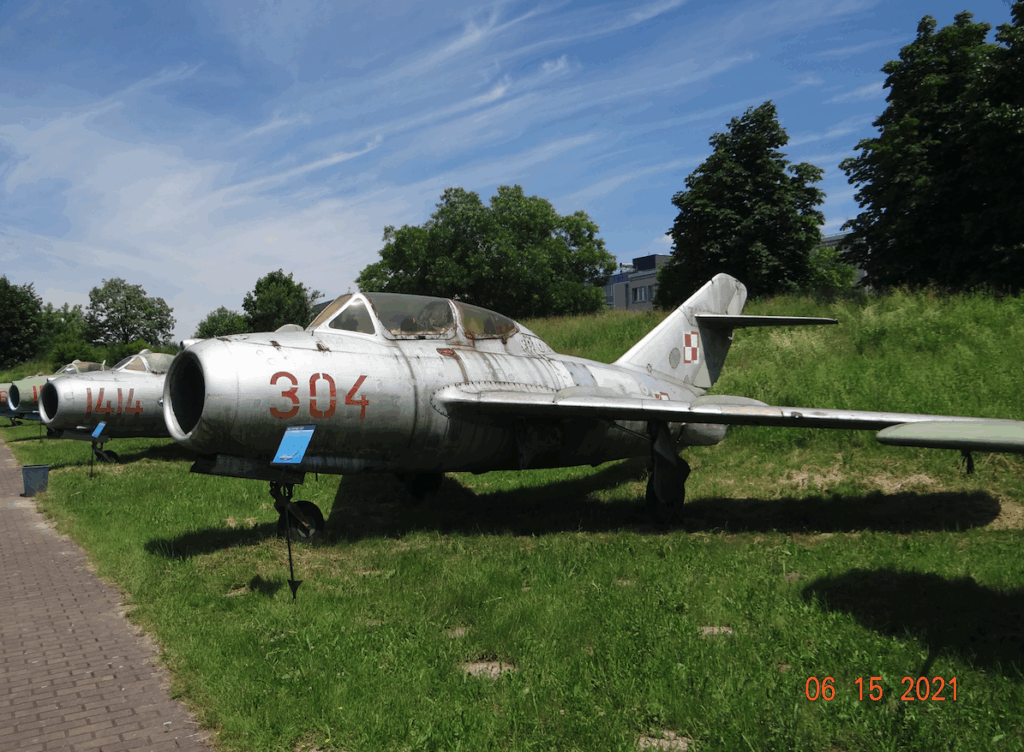
Following the events of the Poznań June 1956 uprising, the regiment retrained pilots from the former Polish Air Force in the West, who were reinstated to military service in the Polish Army. Among them were Major Pilot Stanisław Skalski, Major Pilot Wacław Król, Major Pilot Witold Łokuciewski, Major Pilot Tadeusz Góra, and Major Pilot Ignacy Olszewski.
62nd Air Force Regiment named after the Greater Poland Insurgents of 1918/1919. 1957.
On May 14, 1955, the Warsaw Pact was established. This forced changes in the Polish Air Force. As a result, in August 1957, as part of the reorganization of military aviation, the Krzesiny Regiment became a combat unit and, as the 62nd Fighter Aviation Regiment, became part of the 3rd Air Defense Corps (OK).
The 3rd Air Defense Corps (OK), with headquarters in Wrocław, then comprised four Fighter Regiments: the 3rd Fighter Aviation Regiment Wrocław, the 38th Air Defense Corps Powidz, the 45th Air Defense Corps Babimost, and the 62nd Air Defense Corps Krzesiny. The following also included the 44th Liaison Aviation Squadron from Wrocław, the 14th Air Defense Artillery Regiment in Wrocław, the 98th Air Defense Artillery Regiment in Poznań, and the Radio Engineering Battalions: the 18th Poznań-Ławica and the 22nd Wrocław-Starachowice.
In September 1957, the 62nd Air Defense Corps began serving in the country’s air defense system.
On October 13, 1957, the 62nd Airborne Regiment received its banner from General Pilot Jan Raczkowski. The banner was donated by the crew of the Hipolit Cegielski Factory in Poznań.
On September 6, 1958, at the request of the Poznań public, and primarily the employees of the Hipolit Cegielski Factory in Poznań, the Ministry of National Defense awarded the 62nd Airborne Regiment the distinctive name of the Greater Poland Insurgents of 1918–1919. This name remained until the early 1990s, when the use of collective names of heroes was prohibited.
New combat aircraft. 1958.
In 1958, the 62nd PLM received new Lim-5 fighter aircraft. These aircraft were incorporated into the newly formed 3rd Squadron in the Regiment, which until then had only two squadrons.
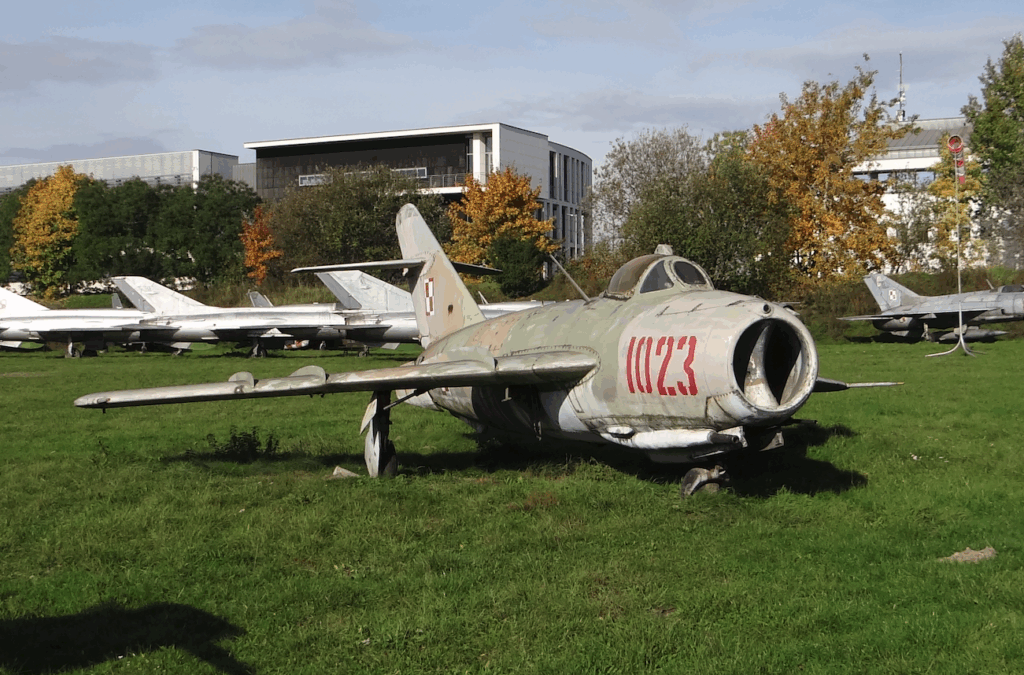
In 1959, the 62nd Fighter Aviation Regiment (PLM) received MiG-19 PM fighters, equipped with radars and anti-aircraft guided missiles. These aircraft did not stay with the Regiment for long. By 1963, all were transferred to the 39th Fighter Aviation Regiment in Mierzęcice.
Despite three plane crashes in 1958, the 62nd Fighter Aviation Regiment achieved first place among fighter aviation regiments in the 3rd Air Defense Corps.
MiG-19s in the 62nd Fighter Aviation Regiment. 1959.
From May to September 1958, at the Higher School of Pilots in Modlin, pilots from the 62nd Air Force Regiment, Captains Skrzydłowski and Góra, and Lieutenants Makarewicz, Oczepko, and Sobczyk (all from the First Squadron), participated in a MiG-19 fighter training course at the Higher School of Pilots in Modlin.
The technical services, previously part of the air squadrons, were separated. A technical division (DT) was formed within the 62nd Air Force Regiment, consisting of three technical squadrons. A missile elaboration section (SER) was also established. The regiment’s engineering section, with its technical service department established in 1957, was also subordinated to the commander of the technical division. The regiment’s senior engineer, Capt. Mieczysław Niedzielski, assumed command of the DT.
In 1959, MiG-19 aircraft were accepted into service with the 1st Squadron in Krzesiny. Initially, these were only the MiG-19 PM versions.
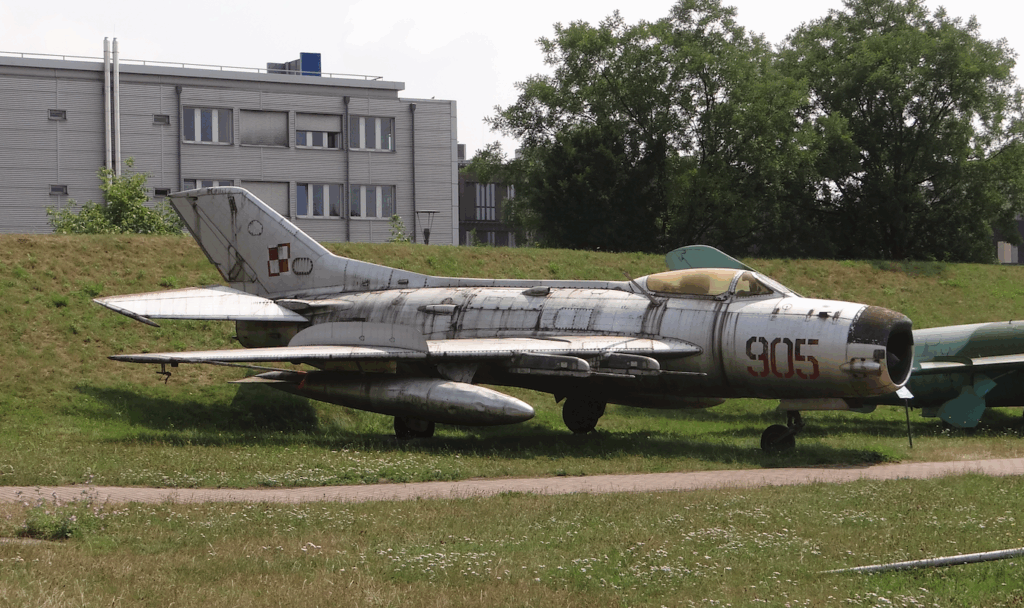
MiG-19 P and PM aircraft were equipped with the 1st Squadron of the 62nd Airborne Regiment until 1962. Since the regiment was selected to receive the state-of-the-art MiG-21 F-13 aircraft, its MiG-19 P and PM aircraft were transferred to the 28th Airborne Regiment in Słupsk and the 39th Airborne Regiment in Mierzęcice.
1962
In the spring of 1962, due to the transformation of the Air and Anti-Aircraft Defense Forces of the National Territory into the National Air Defense Forces, the Regiment’s name was also changed to the 62nd Airborne Regiment of the Air Defense Forces. This took place in March 1963.
MiG-21s in the 62nd Airborne Regiment. 1963
As early as November 1962, it was known that the Regiment would receive supersonic MiG-21 F-13 fighters. In 1963, the 62nd Air Force Regiment received new MiG-21 F-13 fighters, and in 1964, the first MiG-21 PF fighters. The Regiment was the first combat unit equipped with this type of aircraft. MiG-21s represented a new standard in the Polish Army, significantly superior to the MiG-19s. The first pilots and technicians were trained in Modlin, where the Higher Pilotage School was located. All twin-copter MiG-21 U aircraft were also located in Modlin. As subsequent aircraft were delivered to Krzesiny, the training center was moved there. Most aircraft were delivered in crates. In Krzesiny, Russian technicians performed final assembly, and Russian pilots conducted acceptance flights.
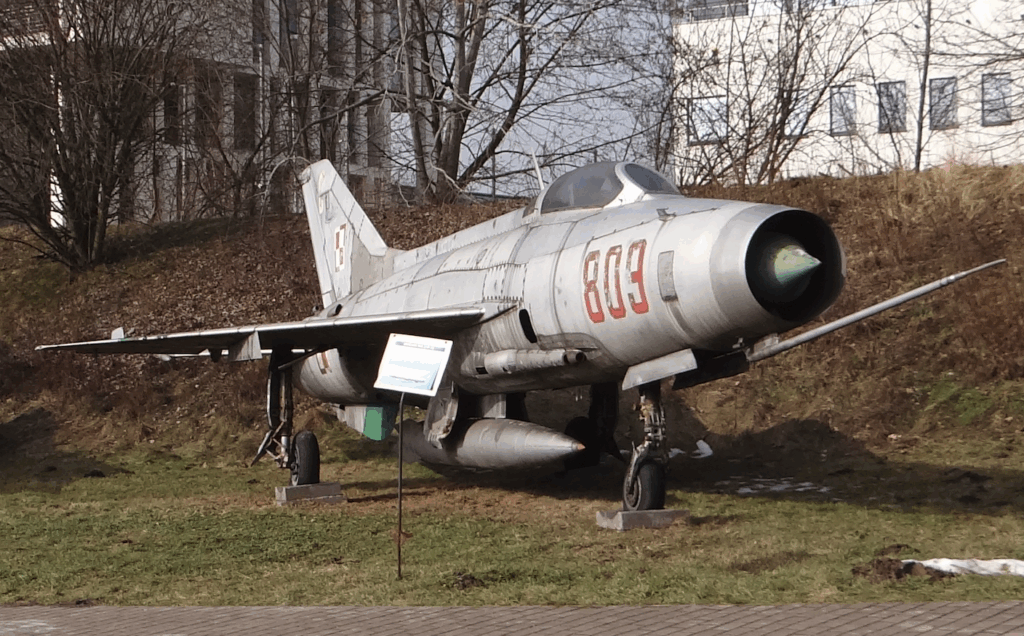
1964.
In 1964, the first An-2 transport and liaison aircraft were introduced to the Regiment. The first example of this aircraft was operated in Krzesiny as late as 2002 and was retired in 2008.
1966.
In June 1966, the Krzesiny Regiment participated in Warsaw Pact exercises, where it performed its first landings and takeoffs from a highway landing zone (DOL). Flights were conducted using Lim-2, Lim-5, and MiG-21 aircraft.
In May of that same year, the unit was forced to relocate to Babimost Airport due to the renovation and refurbishment of its home airport. The next comprehensive renovation of the airfield was carried out in 1973 and 1985, during which, among other things, earthen embankments for aircraft were constructed, followed by shelters and hangars, shelters for squadron crews, and command posts.
1967.
In 1967, the Regiment accepted its first MiG-21U combat trainer aircraft. This allowed it to conduct a full training cycle for MiG-21 pilots. Additionally, MiG-21 pilots for other combat units were trained in Krzesiny.
1970.
Despite the introduction of subsequent versions of supersonic aircraft, the Regiment continued to operate Lim-5 aircraft, which were equipped with the 3rd Squadron. This continued when the first MiG-21 PFM fighters arrived at Krzesiny in 1970. The new MiG-21 PFMs flew in the regiment until 1998.
1971.
In 1971, the unit received MiG-21 US training aircraft. These were a newer version of the MiG-21 U.
1973.
In November 1973, the 62nd Air Force Regiment was once again reorganized. The unit moved from a three-squadron structure to a two-squadron structure. Two Air Squadrons were formed: the 1st Squadron with MiG-21 aircraft, and the 2nd Squadron with Lim-5 aircraft, which remained in service until 1981, when the Squadron received additional MiG-21 PFM aircraft. The new organization officially operated from December 1, 1973.
Also in 1973, another renovation of the Poznań Krzesiny airfield was carried out. The regiment was relocated to Mierzęcice and the Kąkolewo alternate airfield near Grodzisk Wielkopolski, where it remained stationed for almost six months.
1975.
In 1975, the 62nd Airborne Regiment received two new aircraft types. The first was the TS-11 Iskra bis DF combat trainer. The second was the PZL 103 Wilga 35 light liaison aircraft.
In 1975, at the initiative of Lieutenant Colonel Romuald Rejewski, the regiment’s insignia was designed, which harkened back to the pre-war traditions of Poznań air units, depicting an image of a raven stylized to resemble a jet aircraft.
1977.
In 1977, the commander, Lieutenant Colonel Romuald Rejewski, and Lieutenant Colonel Antoni Babkiewicz were killed in a plane crash near the airfield on a MiG-21 US. Maj. Pilot Jan Waliszkiewicz assumed the command position.
1979.
In 1979, the Pilot of the Year and Technician of the Year competitions were introduced. The competition lasted until 2000.
1980.
In 1980, the regiment was relocated to Babimost Airport for the duration of the renovation and modernization of its home airport in 1980 and 1985. In addition to renovations to the runway (RWY) and taxiways, shelters and hangars for MiG-21 fighters were built near the runway and remained in use until 2000.
1981.
In March 1981, operations of the Lim-5 and SB Lim-2 aircraft were discontinued. These aircraft were retired due to financial austerity measures. The socialist economy was mismanaged by the government. During the 1980s, combat units, including the 62nd Airborne Aviation Regiment, saw a significant decline in annual flight hours, which amounted to approximately 2,000 hours.
1989.
At the end of the 1980s, the military aviation was restructured. The Air Force and the National Air Defense Force were merged into the Air Force and Air Defense Force. The new structure’s command was located in Warsaw. At that time, Poland withdrew from the Warsaw Pact, which existed only formally.
The 62nd Air Defense Regiment remained within the 3rd Border Protection Corps (KOP) in Wrocław. Despite the change in Poland’s defense doctrine, the 62nd Air Defense Regiment’s mission remained unchanged. It continued to defend the airspace of Greater Poland, particularly the industrialized Poznań region, in cooperation with missile squadrons, primarily the 79th Air Defense Missile Regiment. The primary aircraft of the 62nd Air Defense Regiment remained the MiG-21 PFM.
1991.
In August 1991, an international aviation event called “Air Show” was organized at Ławica Airport. The 62nd Air Force Aviation Regiment and Krzesiny Airport served as the logistics base and aircraft grouping center. Western combat aircraft, including F-15s, F-16s, Mirage 2000s, and Tornado GRs, were based at the Krzesiny airport. It was the first such aviation event in the history of Poland and Eastern Europe.
On May 3, 1991, during a ceremony in front of the Tomb of the Unknown Soldier in Warsaw, the 62nd Air Force Aviation Regiment was presented with the banner of the Greater Poland Aeronautical Brigade and the heritage of Greater Poland’s air squadrons. The event was organized to commemorate the 200th anniversary of the proclamation of the May 3rd Constitution.
In the mid-1990s, the Polish Army was intensively searching for new combat aircraft to replace the already obsolete MiG-21 fighters. As the search for aircraft and funding sources dragged on, further organizational changes were made.
Aircraft used by the 62nd Air Force Regiment:
UTI MiG-15, MiG-15, Lim-1, Yak-11, Lim-2, Lim-5, SB Lim-2, MiG-19 PM (P), MiG-21 F-13, MiG-21 PF, MiG-21 PFM, MiG-21 U, MiG-21 MF, MiG-21 R, TS-11 Iskra bis, PZL 103 Wilga 35.
Commanders of the 62nd Air Force Regiment:
Capt. Pilot Andrzej Dobrzeniecki from 1954, Capt. Pilot Józef Sobieraj from 1.10.1959, Lt. Col. pilot Mirosław Kapciuch from 10.10.1961, Major pilot Mieczysław Sroka from December 1963, Major pilot Kazimierz Krata from September 1968, Lt. Col. pilot Romuald Rejewski from 1975, Major pilot Jan Waliszkiewicz from 1977, Lt. Col. pilot Marian Urbański from 30.06.1980, Lt. Col. pilot Henryk Materna from 1985, Lt. Col. pilot Jerzy Gruca from 1987, Lt. Col. pilot Gwidon Haławin from 1989, Major pilot Antoni Masłowski from 29.01.1993.
Written by Karol Placha Hetman

